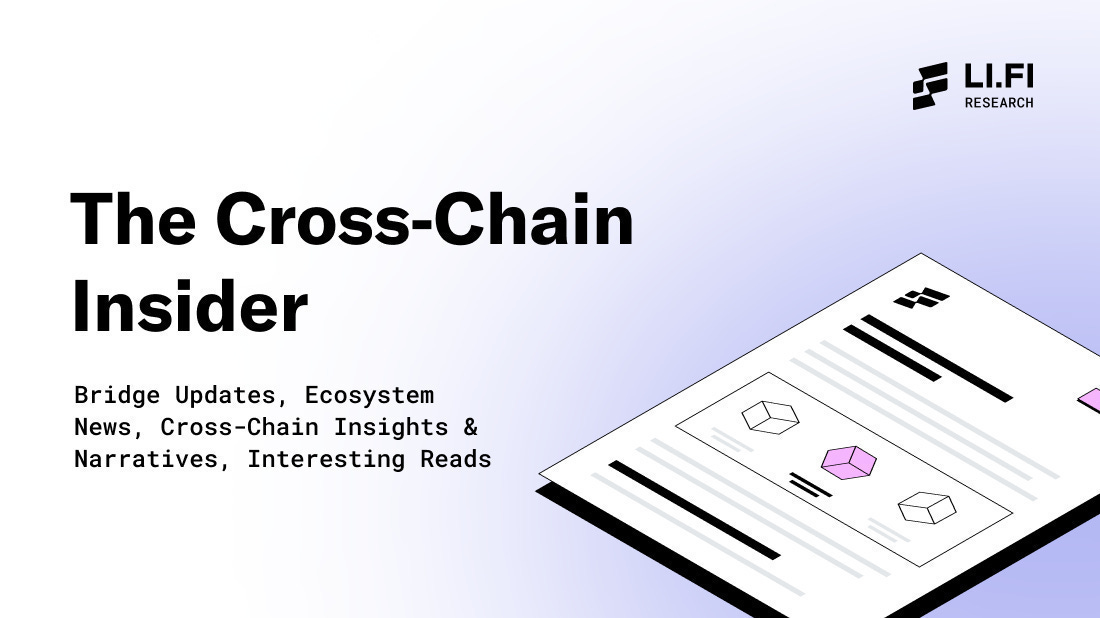Base Bridge Live | Polygon zkEVM Live on LI.FI | OP Stack-Hyperlane & More!
Last Week In The Multi-Chain Ecosystem (31 July - 06 Aug '23)
Welcome to LI.FI’s Cross Chain Insider newsletter. If you want to join this community of cross-chain aficionados learning about bridges, interoperability, and the multi-chain ecosystem, subscribe below.
You can also check out LI.FI’s research articles, and follow us on Twitter!
Bridge Updates
Bridging to Base L2 is now open and Base’s Mainnet will launch on August 9, coinciding with the Onchain Summer campaign. During this event, users can mint NFTs from top-tier companies.
Bridges such as Rebase, Orbiter, Hop, Squid, Wormhole, Synapse, Stargate, among others, have added support for bridging to Base.
2) Polygon zkEVM Live on LI.FI 💜
Polygon’s zkEVM is now live on LI.FI. Developers can add support for zkEVM effortlessly by integrating LI.FI’s API, SDK, and widget, whereas users can bridge & swap to explore zkEVM’s ecosystem via Jumper.exchange.
3) Introducing OP-Stack-Hyperlane 🔥
Op-Stack-Hyperlane is an OP Stack mod that bundles Hyperlane deployment into any L2 to enable fast token withdrawals and cross-domain messaging, among other features.
4) Aura Partners with LayerZero 🤝
Aura, a DeFi protocol built on top of Balancer, has launched $AURA as an Omnichain Fungible Token (OFT) on LayerZero to enable bridging between supported chains, including Ethereum, Arbitrum, Optimism, and Polygon.
5) Concero, Locus Finance & Skipper Integrate LI.FI 🦎
LI.FI announced several integrations in the past week, including:
Concero, a new cross-chain DEX aggregator, has integrated LI.FI’s API.
Locus Finance, a platform for decentralized asset management that offers tokenized yield-bearing vaults of strategies, has Integrated LI.FI & Wido’s widget into their dApp.
Skipper, an intent-based transaction navigator, has Integrated LI.FI’s API to enable users to move their existing assets from any chain and receive any desired asset seamlessly across six chains.
Multi-Chain Ecosystem Updates
1) $BALD Rugpull & LeetSwap Exploit on Base ☠️
Base L2 experienced a rug pull even before its mainnet launch as the developer behind the memecoin $BALD, removed 6,800 ETH (~$12.5M) from the $BALD liquidity pool on LeetSwap, resulting in a liquidity crunch and a ~90% price drop on $BALD.
LeetSwap DEX halted trading on the platform due to an exploit after the $BALD rugpull that led to a $630k (340ETH) loss. This forced birding protocols like Squid to seek alternative DEXs to support any-2-any swaps to Base.
2) Introducing Mangata: Multi-Rollup Interchain Infrastructure 💪
Mangata is a multi-rollup interchain infrastructure for native cross-chain swaps.
As per the team, “the multi-rollup provides a trust- and risk-minimized architecture compared to traditional bridges and avoids centralized parties or additional layers of economic security.”
3) Celo’s Transition to an Ethereum L2 Approved 🎉
The governance proposal for “Celo returning home to Ethereum by transitioning from being an independent EVM-compatible Layer 1 blockchain to an Ethereum Layer 2” has been approved.
4) Account Abstraction Endpoint on Arbitrum 🔥
AIP-2 has officially passed and the Account Abstraction endpoint is now active on Arbitrum. AIP-2 improves support for Account Abstraction, making development around Smart Contract Wallets easier.
5) Polygon x zkSync Drama TLDR ⚔️
In an article titled “Protect the Open Source Ethos”, the Polygon Zero team accused Matter Labs, the developers behind zkSync, of releasing a proving system called "Boojum" that allegedly contains significant portions of code copied from the Plonky2 library.
They claim that this was done without proper copyrights or clear recognition to the original creators, namely the Polygon Zero team.
The team emphasized the importance of the open-source ethos in the crypto community and expressed disappointment that zkSync appeared to breach this principle by not giving due credit and making potentially misleading claims about the source of the work.
The reply of Alex G, co-founder and CEO of Matter Labs, can be found here.
What’s Popping?
Things are shaking up big time in crypto. There's a bunch of new stuff popping up that could change how we think about crypto economics and the cross-chain / multi-chain ecosystem.
Today, we're gonna summarize about 10 of these cool new things.
I’ll link details for each topic in the heading of each section (which you should go and read) and then give a few lines of commentary.
You can think of this version of WP as your cheat sheet to getting up to speed on what interop nerds like Kram and I are DMing about in our free time.
Let’s dive in!
10 Things I Think I'm Thinking About…
1. xERC20
A welcome initiative from the Connext team to create a bridge-agnostic token standard — which is much needed in a world where bridges are competing to onboard projects to various token standards and, therefore, opening up the potential for harmful vendor lock-in. Bridge-agnostic standardization in a world with 10s of bridges and 1000s of chains will go a long way in minimizing the damage a single bridge hack can do. As aggregators, LI.FI is all for supporting neutral and protocol-agnostic solutions.
PS. Kram isn't digging the name xERC20. But I kinda get it – the "x" stands for cross-chain, and since everyone knows what ERC20 is, it's pretty clear what they're getting at.
2. Multi-Message Aggregation (MMA)
A simple concept: use multiple bridges to confirm cross-chain transactions. In an ecosystem where bridge hacks are common, any high-value transaction ($100M+ tx) or message (governance decision) shouldn’t rely on a single bridge. MMA addresses a pivotal issue in the cross-chain landscape: ensuring the accuracy of message verification, especially for chains that lack standardized bridges with Ethereum. I anticipate MMA will emerge as the preferred solution for applications such as cross-chain governance.
3. Intents
Intents were previously referred to as 'preferences' and can be seen in UX flows of applications like CoW Swap, but never really gained traction as they have in 2023.
Intents are cool, and the aim is right — simplifying crypto for the average user — though it is my opinion that maybe intents will not change that much in terms of how crypto UIs look, as current intent-based protocols are only designed for simple limit orders. In reality, intents are very theoretical at the moment. I’ll start getting more excited when applications begin plugging into intent-based infra like SUAVE and Anoma in the backend to solve user intents.
Nonetheless, intents emphasize the importance of developing crypto applications that are user-friendly and don't necessitate users to grasp every intricacy of how to best perform on-chain activities.
4. UniswapX
Bluechips like Uniswap are finally going cross-chain, though not quite in the manner many anticipated. Instead of going cross-chain through existing bridges, as our aggregator-biased thesis went in 2021 and 2022, Uniswap introduced UniswapX, an RFQ-based system that can support both same and cross-chain swaps. This design combines the mechanisms of existing liquidity-based bridges like Across and the solving that comes with the market maker networks pioneered at 0x and 1inch Fusion.
UniswapX stands to significantly transform the cross-chain landscape, holding the potential to capture a substantial portion of cross-chain transactions, especially for key assets and chains.
5. CoW Hooks
Hooks are custom DeFi actions that can be executed before/after trades — transforming CoW Protocol into a multi-purpose intent execution engine. This is a really cool concept, but needs someone to build an application on top of it to capture attention.
Interestingly, this resembles the methodology of bridges like Connext and aggregators like LI.FI, which both offer developers the ability to generate “contract calls” to facilitate multi-step transactions, such as Bridge + Swap + Stake. Hence, enabling something like a CoW Hook has been a possibility for a while now.
6. Essential
One of the more exciting projects to have been announced recently. While it aligns with the intents narrative, it brings a fresh perspective by aiming to develop a universal domain-specific language (DSL) for intents. Moreover, the team has plans to build a “Modular Intent Layer”, which will compete with Anoma and SUAVE on some level.
The world of 1000 chains is fast approaching and IMO, most projects aren’t ready or in fact, many may not fully grasp the repercussions of technologies like Superchain, Subnets, Supernets, and dappchains on our ecosystem. It’s something that we’re spending a lot of time and resources to understand at LI.FI and how to best position ourselves.
8. Catalyst
Cayalyst is a cross-chain AMM that is making a bet that the ecosystem will have 100s of chains and is building a solution to enable swaps between all these chains. It’s an elegant, math-based solution that’s thinking about serving the world of 1000s chains from the get-go and I believe that’ll help them stand out.
It's been a while since we at LI.FI came across a whitepaper introducing a truly unique concept. While UniswapX and Hyperlane's Khalani are commendable solutions that fulfill specific needs, they draw significantly from pre-existing concepts, designs, and architectures.
10. Chainlink Cross-Chain Interoperability Protocol (CCIP)
I have mixed thoughts on CCIP. While it's logical for Chainlink to roll out a cross-chain solution, capitalizing on their reach, CCIP launch is perhaps a year too late as players like LayerZero, Axelar, and Wormhole have established strong distribution and presence in the ecosystem and it’ll be difficult for any new player to compete.
Interesting Reads
1) Future of Smart Accounts: Modular, Specialised & Multichain
2) Endgame: Proof of Governance
3) How Flash Loans Could Work in Shared Sequencers
5) Intent-Based Architectures and Projects Experimenting with Them
Get Started With LI.FI Today
For more information about the LI.FI protocol,
Head to our link portal at link3.to/lifi
Read our SDK’ quick start’ at docs.li.fi
Join the official Discord server
Follow our Telegram Newsletter
Subscribe on our Substack
or try our any-2-any swaps NOW at jumper.exchange







When will you integrate BASE on your SDK